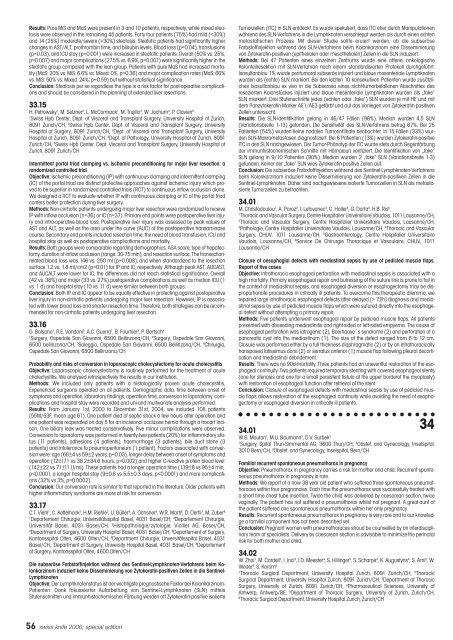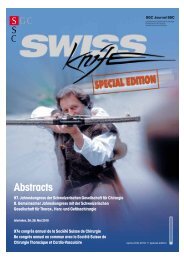Abstracts 4. Gemeinsamer Jahreskongress der ... - SWISS KNIFE
Abstracts 4. Gemeinsamer Jahreskongress der ... - SWISS KNIFE
Abstracts 4. Gemeinsamer Jahreskongress der ... - SWISS KNIFE
Create successful ePaper yourself
Turn your PDF publications into a flip-book with our unique Google optimized e-Paper software.
swissknife spezial 06 12.06.2006 13:39 Uhr Seite 56<br />
Results: Pure MiS and MaS were present in 3 and 10 patients, respectively, while mixed steatosis<br />
were observed in the remaining 45 patients. Forty four patients (75%) had mild (30%) steatosis. Steatotic patients had significantly higher<br />
changes in AST/ALT, prothrombin time, and bilirubin levels. Blood loss (p=0.04), transfusions<br />
(p=0.03), and ICU stay (p=0.001) were increased in steatotic patients. Overall (50% vs. 25%,<br />
p=0.007) and major complications (27.5% vs. 6.9%, p=0.001) were significantly higher in the<br />
steatotic group compared with the lean group. Patients with pure MaS had increased mortality<br />
(MaS: 20% vs. MiS: 6.6% vs. Mixed: 0%, p=0.36) and major complication rates (MaS: 66%<br />
vs. MiS: 50% vs. Mixed: 24%; p=0.59) but without statistical significance.<br />
Conclusion: Steatosis per se regardless the type is a risk factor for post-operative complications<br />
and should be consi<strong>der</strong>ed in the planning of extended liver resections.<br />
33.15<br />
H. Petrowsky 1 , M. Selzner 2 , L. McCormack 1 , M. Trujillo 3 , W. Jochum 4 , P. Clavien 5<br />
1 Swiss Hpb Center, Dept. of Visceral and Transplant Surgery, University Hospital of Zurich,<br />
8091 Zurich/CH, 2 Swiss Hpb Center, Dept. of Visceral and Transplant Surgery, University<br />
Hospital of Surgery, 8091 Zurich/CH, 3 Dept. of Visceral and Transplant Surgery, University<br />
Hospital of Zurich, 8091 Zurich/CH, 4 Dept. of Pathology, University Hospital of Zurich, 8091<br />
Zurich/CH, 5 Swiss Hpb Center, Dept. Visceral and Transplant Surgery, University Hospital of<br />
Zurich, 8091 Zurich/CH<br />
Intermittent portal triad clamping vs. ischemic preconditioning for major liver resection: a<br />
randomized controlled trial<br />
Objective: Ischemic preconditioning (IP) with continuous clamping and intermittent clamping<br />
(IC) of the portal triad are distinct protective approaches against ischemic injury which proved<br />
to be superior in randomized controlled trials (RCT) to continuous inflow occlusion alone.<br />
We designed a RCT to evaluate whether IP with continuous clamping or IC of the portal triad<br />
confers better protection during liver surgery.<br />
Methods: Non-cirrhotic patients un<strong>der</strong>going major liver resection were randomized to receive<br />
IP with inflow occlusion (n=36) or IC (n=37). Primary end points were postoperative liver injury<br />
and intra-operative blood loss. Postoperative liver injury was assessed by peak values of<br />
AST and ALT, as well as the area un<strong>der</strong> the curve (AUC) of the postoperative transaminase<br />
course. Secondary end points included resection time, the need of blood transfusion, ICU and<br />
hospital stay as well as postoperative complications and mortality.<br />
Results: Both groups were comparable regarding demographics, ASA score, type of hepatectomy,<br />
duration of inflow occlusion (range: 30-75 min), and resection surface. The transectionrelated<br />
blood loss was 146 vs. 250 ml (p=0.008), and when standardized to the resection<br />
surface 1.2 vs. 1.8 ml/cm2 (p=0.01) for IP and IC, respectively. Although peak AST, AUCAST,<br />
and AUCALT were lower for IC, the differences did not reach statistical significance. Overall<br />
(42 vs. 38%) and major (33 vs. 27%) postoperative complications as well as median ICU (1<br />
vs. 1 d) and hospital stay (10 vs. 11 d) were similar between both groups.<br />
Conclusion: Both IP and IC appear to be equally effective in protecting against postoperative<br />
liver injury in non-cirrhotic patients un<strong>der</strong>going major liver resection. However, IP is associated<br />
with lower blood loss and shorter resection time. Therefore, both strategies can be recommended<br />
for non-cirrhotic patients un<strong>der</strong>going liver resection.<br />
33.16<br />
G. Balsano 1 , R.E. Vandoni 2 , A.C. Guerra 1 , B. Fournier 3 , P. Gertsch 4<br />
1 Surgery, Ospedale San Giovanni, 6500 Bellinzona/CH, 2 Surgery, Ospedale San Giovanni,<br />
6500 bellinzona/CH, 3 Soleggio, Ospedale San Giovanni, 6500 Bellinzona/CH, 4 Chirurgia,<br />
Ospedale San Giovanni, 6500 Bellinzona/CH<br />
Probability and risks of conversion in laparoscopic cholecystectomy for acute cholecystitis<br />
Objective: Laparoscopic cholecystectomy is routinely performed for the treatment of acute<br />
cholectystitis. We analysed retrospectively the results in our institution.<br />
Methods: We included only patients with a histologically proven acute cholecystitis.<br />
Experienced surgeons operated on all patients. Demographic data, time between onset of<br />
symptoms and operation, laboratory findings, operation time, conversion to laparatomy, complications<br />
and hospital stay were recorded and uni-and multivariate analysis performed.<br />
Results: From January 1st, 2000 to December 31st, 2004, we included 108 patients<br />
(55M/53F, mean age 61). One patient died of septic shock a few hours after operation and<br />
one patient was reoperated on day 5 for an incisional occlusive hernia through a trocart incison.<br />
One biliary leak was treated conservatively. Five minor complications were observed.<br />
Conversion to laparotomy was performed in twenty-two patients (20%) for inflammatory status<br />
(11 patients), adhesions (4 patients), haemorrhage (3 patients), bile duct stone (3<br />
patients) and intolerance to pneumoperitoneum (1 patient). Factors associated with conversion<br />
were: age (68±4 vs 59±2 years, p=0.03), longer delay between onset of symptoms and<br />
operation (12±17.1 vs 38.2±3<strong>4.</strong>6 hours, p=0.002) and higher C-reactive protein blood level<br />
(142±22 vs 71±11 U/ml). These patients had a longer operation time (139±8 vs 95±4 min,<br />
p
















